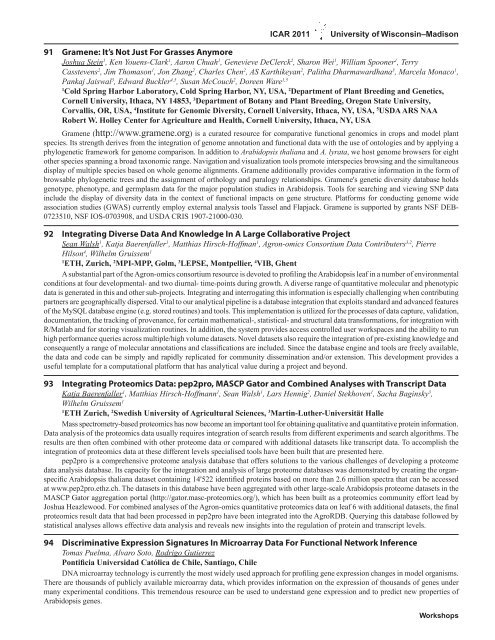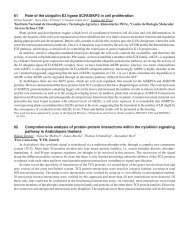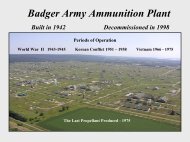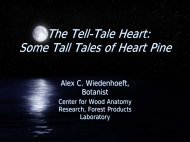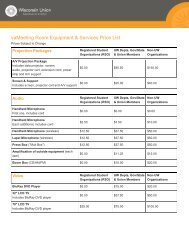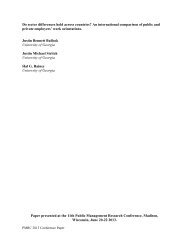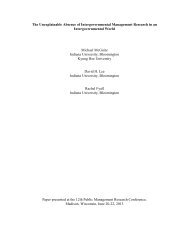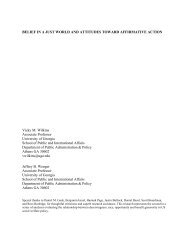Full Abstract Book - Wisconsin Union - University of Wisconsin ...
Full Abstract Book - Wisconsin Union - University of Wisconsin ...
Full Abstract Book - Wisconsin Union - University of Wisconsin ...
You also want an ePaper? Increase the reach of your titles
YUMPU automatically turns print PDFs into web optimized ePapers that Google loves.
ICAR 2011<br />
<strong>University</strong> <strong>of</strong> <strong>Wisconsin</strong>–Madison<br />
91 Gramene: It’s Not Just For Grasses Anymore<br />
Joshua Stein 1 , Ken Youens-Clark 1 , Aaron Chuah 1 , Genevieve DeClerck 2 , Sharon Wei 1 , William Spooner 1 , Terry<br />
Casstevens 2 , Jim Thomason 1 , Jon Zhang 2 , Charles Chen 2 , AS Karthikeyan 2 , Palitha Dharmawardhana 3 , Marcela Monaco 1 ,<br />
Pankaj Jaiswal 3 , Edward Buckler 4,5 , Susan McCouch 2 , Doreen Ware 1,5<br />
1<br />
Cold Spring Harbor Laboratory, Cold Spring Harbor, NY, USA, 2 Department <strong>of</strong> Plant Breeding and Genetics,<br />
Cornell <strong>University</strong>, Ithaca, NY 14853, 3 Department <strong>of</strong> Botany and Plant Breeding, Oregon State <strong>University</strong>,<br />
Corvallis, OR, USA, 4 Institute for Genomic Diversity, Cornell <strong>University</strong>, Ithaca, NY, USA, 5 USDA ARS NAA<br />
Robert W. Holley Center for Agriculture and Health, Cornell <strong>University</strong>, Ithaca, NY, USA<br />
Gramene (http://www.gramene.org) is a curated resource for comparative functional genomics in crops and model plant<br />
species. Its strength derives from the integration <strong>of</strong> genome annotation and functional data with the use <strong>of</strong> ontologies and by applying a<br />
phylogenetic framework for genome comparison. In addition to Arabidopsis thaliana and A. lyrata, we host genome browsers for eight<br />
other species spanning a broad taxonomic range. Navigation and visualization tools promote interspecies browsing and the simultaneous<br />
display <strong>of</strong> multiple species based on whole genome alignments. Gramene additionally provides comparative information in the form <strong>of</strong><br />
browsable phylogenetic trees and the assignment <strong>of</strong> orthology and paralogy relationships. Gramene's genetic diversity database holds<br />
genotype, phenotype, and germplasm data for the major population studies in Arabidopsis. Tools for searching and viewing SNP data<br />
include the display <strong>of</strong> diversity data in the context <strong>of</strong> functional impacts on gene structure. Platforms for conducting genome wide<br />
association studies (GWAS) currently employ external analysis tools Tassel and Flapjack. Gramene is supported by grants NSF DEB-<br />
0723510, NSF IOS-0703908, and USDA CRIS 1907-21000-030.<br />
92 Integrating Diverse Data And Knowledge In A Large Collaborative Project<br />
Sean Walsh 1 , Katja Baerenfaller 1 , Matthias Hirsch-H<strong>of</strong>fman 1 , Agron-omics Consortium Data Contributers 3,2 , Pierre<br />
Hilson 4 , Wilhelm Gruissem 1<br />
1<br />
ETH, Zurich, 2 MPI-MPP, Golm, 3 LEPSE, Montpellier, 4 VIB, Ghent<br />
A substantial part <strong>of</strong> the Agron-omics consortium resource is devoted to pr<strong>of</strong>iling the Arabidopsis leaf in a number <strong>of</strong> environmental<br />
conditions at four developmental- and two diurnal- time-points during growth. A diverse range <strong>of</strong> quantitative molecular and phenotypic<br />
data is generated in this and other sub-projects. Integrating and interrogating this information is especially challenging when contributing<br />
partners are geographically dispersed. Vital to our analytical pipeline is a database integration that exploits standard and advanced features<br />
<strong>of</strong> the MySQL database engine (e.g. stored routines) and tools. This implementation is utilized for the processes <strong>of</strong> data capture, validation,<br />
documentation, the tracking <strong>of</strong> provenance, for certain mathematical-, statistical- and structural data transformations, for integration with<br />
R/Matlab and for storing visualization routines. In addition, the system provides access controlled user workspaces and the ability to run<br />
high performance queries across multiple/high volume datasets. Novel datasets also require the integration <strong>of</strong> pre-existing knowledge and<br />
consequently a range <strong>of</strong> molecular annotations and classifications are included. Since the database engine and tools are freely available,<br />
the data and code can be simply and rapidly replicated for community dissemination and/or extension. This development provides a<br />
useful template for a computational platform that has analytical value during a project and beyond.<br />
93 Integrating Proteomics Data: pep2pro, MASCP Gator and Combined Analyses with Transcript Data<br />
Katja Baerenfaller 1 , Matthias Hirsch-H<strong>of</strong>fmann 1 , Sean Walsh 1 , Lars Hennig 2 , Daniel Stekhoven 1 , Sacha Baginsky 3 ,<br />
Wilhelm Gruissem 1<br />
1<br />
ETH Zurich, 2 Swedish <strong>University</strong> <strong>of</strong> Agricultural Sciences, 3 Martin-Luther-Universität Halle<br />
Mass spectrometry-based proteomics has now become an important tool for obtaining qualitative and quantitative protein information.<br />
Data analysis <strong>of</strong> the proteomics data usually requires integration <strong>of</strong> search results from different experiments and search algorithms. The<br />
results are then <strong>of</strong>ten combined with other proteome data or compared with additional datasets like transcript data. To accomplish the<br />
integration <strong>of</strong> proteomics data at these different levels specialised tools have been built that are presented here.<br />
pep2pro is a comprehensive proteome analysis database that <strong>of</strong>fers solutions to the various challenges <strong>of</strong> developing a proteome<br />
data analysis database. Its capacity for the integration and analysis <strong>of</strong> large proteome databases was demonstrated by creating the organspecific<br />
Arabidopsis thaliana dataset containing 14'522 identified proteins based on more than 2.6 million spectra that can be accessed<br />
at www.pep2pro.ethz.ch. The datasets in this database have been aggregated with other large-scale Arabidopsis proteome datasets in the<br />
MASCP Gator aggregation portal (http://gator.masc-proteomics.org/), which has been built as a proteomics community effort lead by<br />
Joshua Heazlewood. For combined analyses <strong>of</strong> the Agron-omics quantitative proteomics data on leaf 6 with additional datasets, the final<br />
proteomics result data that had been processed in pep2pro have been integrated into the AgroRDB. Querying this database followed by<br />
statistical analyses allows effective data analysis and reveals new insights into the regulation <strong>of</strong> protein and transcript levels.<br />
94 Discriminative Expression Signatures In Microarray Data For Functional Network Inference<br />
Tomas Puelma, Alvaro Soto, Rodrigo Gutierrez<br />
Pontificia Universidad Católica de Chile, Santiago, Chile<br />
DNA microarray technology is currently the most widely used approach for pr<strong>of</strong>iling gene expression changes in model organisms.<br />
There are thousands <strong>of</strong> publicly available microarray data, which provides information on the expression <strong>of</strong> thousands <strong>of</strong> genes under<br />
many experimental conditions. This tremendous resource can be used to understand gene expression and to predict new properties <strong>of</strong><br />
Arabidopsis genes.<br />
Workshops


